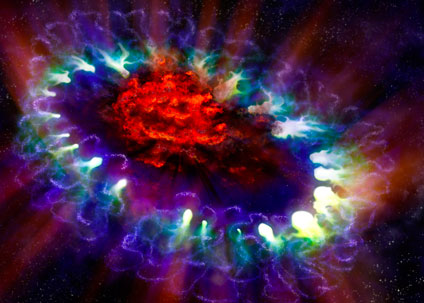Galaxies can be remarkably dusty places and supernovas are thought to be a primary source of that dust, especially in the early Universe. Direct evidence of a supernova’s dust-making capabilities, however, has been slim and cannot account for the copious amount of dust detected in young, distant galaxies.
Striking new observations with the Atacama Large Millimeter/submillimeter Array (ALMA) telescope capture, for the first time, the remains of a recent supernova brimming with freshly formed dust. If enough of this dust makes the perilous transition into interstellar space, it could explain how many galaxies acquired their dusty, dusky appearance.

This artist's illustration of supernova 1987A reveals the cold, inner regions of the exploded star's remnants (in red) where tremendous amounts of dust were detected and imaged by ALMA. This inner region is contrasted with the outer shell (lacy white and blue circles), where the energy from the supernova is colliding with the envelope of gas ejected from the star prior to its powerful detonation.
For a little more insight into the project see this: https://public.nrao.edu/news/pressreleases/alma-images-supernova-dust-factory

